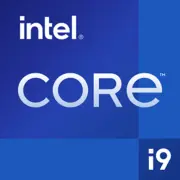Intel Core i9-12900K

Intel Core i9-12900K: Recensione completa del processore del 2025
Architettura, prestazioni e consigli per il montaggio
Caratteristiche principali: architettura ibride e frequenze record
Il processore Intel Core i9-12900K, rilasciato alla fine del 2021, rimane attuale per gli appassionati nel 2025 grazie alla sua unica architettura ibrida Alder Lake.
Architettura e processo produttivo
- Nuclei ibridi: 16 nuclei (8 Performance-cores con Hyper-Threading e 8 Efficient-cores) e 24 thread. I nuclei P sono dedicati ai compiti pesanti (giochi, rendering), mentre i nuclei E si occupano dei processi in background.
- Intel 7 (10 nm Enhanced SuperFin): Migliore efficienza energetica e densità di transistor.
- Frequenze: Base di 3.2 GHz, massima in modalità turbo di 5.1 GHz per i nuclei P. Nei test reali (ad esempio, in Cinebench R23) il processore raggiunge fino a 27.000 punti in modalità multithread.
- Cache: 30 MB di L3 — riduce la latenza quando si lavorano applicazioni ad alta intensità di risorse.
- Intel UHD Graphics 770: Grafica integrata per attività d’ufficio, ma non adatta per i giochi.
Caratteristiche chiave:
- Intel Thread Director: Ottimizza la distribuzione dei compiti tra i nuclei in Windows 11.
- Supporto PCIe 5.0: Larghezza di banda raddoppiata rispetto al PCIe 4.0 — rilevante per SSD e schede grafiche di nuova generazione.
Schede madri compatibili: socket LGA 1700 e chipset
Il processore utilizza il socket LGA 1700, supportato dai chipset Z690, H670, B660 e H610.
Raccomandazioni per la scelta
- Per overclocking: Solo chipset Z690/Z790 (ad esempio, ASUS ROG Strix Z790-E, prezzo ~$350).
- Senza overclocking: B660 (MSI MAG B660 Tomahawk, ~$180) — ottimale per la maggior parte degli utenti.
- Caratteristiche:
- PCIe 5.0 x16 per schede grafiche e PCIe 4.0 x4 per NVMe.
- Alcune schede supportano DDR4 e DDR5 (la scelta dipende dal budget).
Esempio pratico: La scheda Gigabyte Z690 AORUS Master permette di overcloccare l’i9-12900K a 5.3 GHz sui nuclei P utilizzando un sistema di raffreddamento a liquido.
Memoria supportata: DDR4 vs DDR5
Il processore è compatibile con entrambi i tipi di memoria, ma ci sono delle nuance:
- DDR4-3200: Più economica (32 GB ~$90), ma limitata in ampiezza di banda.
- DDR5-6000: Più costosa (32 GB ~$150), ma con prestazioni superiori in attività di rendering (fino al +15% in Blender).
Consiglio: Per i giochi la differenza è minima (1-3% FPS), ma la DDR5 è vantaggiosa per i professionisti.
Alimentatori: calcolo della potenza
Con un TDP di 125 W, il consumo energetico reale sotto carico può raggiungere 250 W (con overclocking).
Raccomandazioni:
- Senza scheda video discreta: 500 W.
- Con scheda video (ad esempio, RTX 4080): 850-1000 W (Corsair RM850x, ~$140).
- Criteri: Certificazione 80 Plus Gold/Platinum, cavi modulari.
Importante: Alimentatori economici (ad esempio, EVGA 600W) potrebbero non gestire i carichi di picco, causando riavvii.
Vantaggi e svantaggi dell’i9-12900K
Vantaggi:
1. Miglior prestazione single-thread (Geekbench 6 Single Core — 2611) — ideale per i giochi (Cyberpunk 2077, 144+ FPS a 1440p).
2. Supporto per DDR5 e PCIe 5.0 — un investimento per il futuro.
3. Architettura ibrida — ottimizzazione dei consumi.
Svantaggi:
1. Elevata temperatura: Senza un sistema di raffreddamento a liquido (ad esempio, NZXT Kraken X63), le temperature sotto carico possono raggiungere 100°C.
2. Prezzo: Nel 2025, il processore costa ~$450, mentre il Ryzen 9 7900X costa $400.
3. Richiede Windows 11 per un corretto funzionamento del Thread Director.
Scenari d’uso
Gaming:
- Massimo FPS in giochi CPU-bound (CS2, Dota 2).
- Compatibile con monitor a 240 Hz.
Attività lavorative:
- Rendering in Blender fino al 30% più veloce rispetto all’i9-11900K.
- Codifica video in Premiere Pro — 8K in 12-15 minuti.
Multimedia:
- Streamming senza lag (OBS + gioco) grazie ai nuclei E.
Confronto con i concorrenti
1. AMD Ryzen 9 7950X (16 nuclei, 32 thread):
- Vantaggi: Migliore in attività multithreading (Geekbench 6 Multi Core — 16.200 vs 15.434 di Intel).
- Svantaggi: Prezzo più alto ($550), performance inferiori nei giochi (-7% FPS).
2. Intel Core i9-13900K:
- Vantaggi: +15% di prestazioni, ma più costoso (~$600).
Conclusione: l’i9-12900K rappresenta il giusto compromesso tra prezzo e prestazioni.
Consigli pratici per il montaggio
1. Raffreddamento: Minimo un dissipatore ad aria (Noctua NH-D15), ottimale un sistema di raffreddamento a liquido da 280 mm.
2. Case: Buona ventilazione (Lian Li Lancool III) + almeno 3 ventole.
3. Aggiornamento BIOS: Per compatibilità con Windows 11 e nuovi SSD.
4. Memoria: Se il budget è limitato — DDR4-3600 CL16 (G.Skill Ripjaws V).
Conclusione: A chi è adatto l’i9-12900K?
Questo processore è consigliato per:
- Gamer che cercano il massimo FPS.
- Professionisti che lavorano con 3D e video.
- Appassionati che apprezzano l’equilibrio tra prezzo e nuove tecnologie.
Alternative: Per il lavoro multithread puro — Ryzen 9 7950X, per il risparmio — i7-13700K.
Nel 2025, l’i9-12900K rimane un’ottima scelta, soprattutto nel mercato dell'usato (prezzo ~$300), ma i nuovi modelli consumano meno energia e sono meglio ottimizzati.
Di base
Specifiche della CPU
Specifiche della memoria
Specifiche della GPU
Varie
Classifiche
Rispetto ad altre CPU
Condividi sui social media
Oppure linkaci
<a href="https://cputronic.com/it/cpu/intel-core-i9-12900k" target="_blank">Intel Core i9-12900K</a>